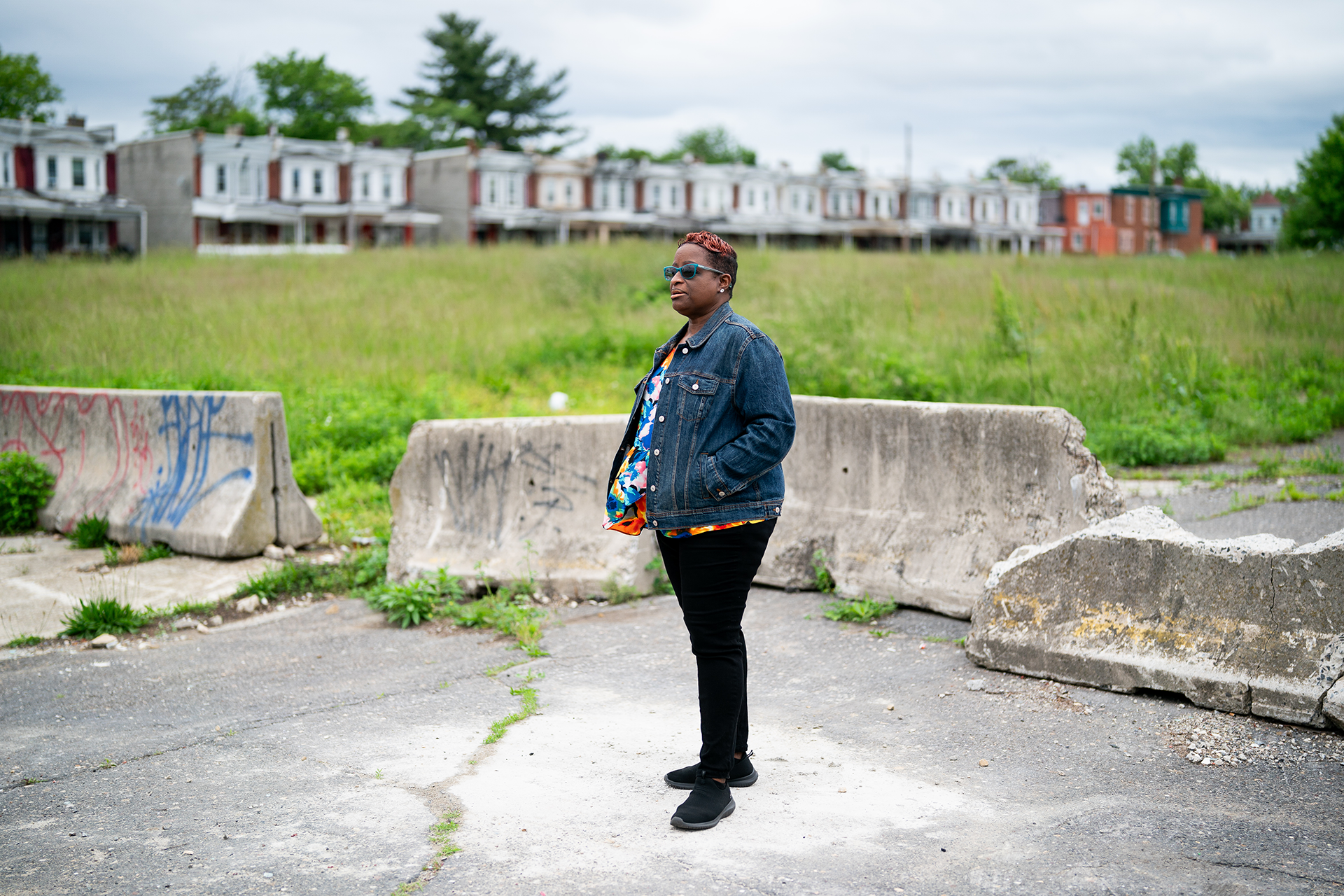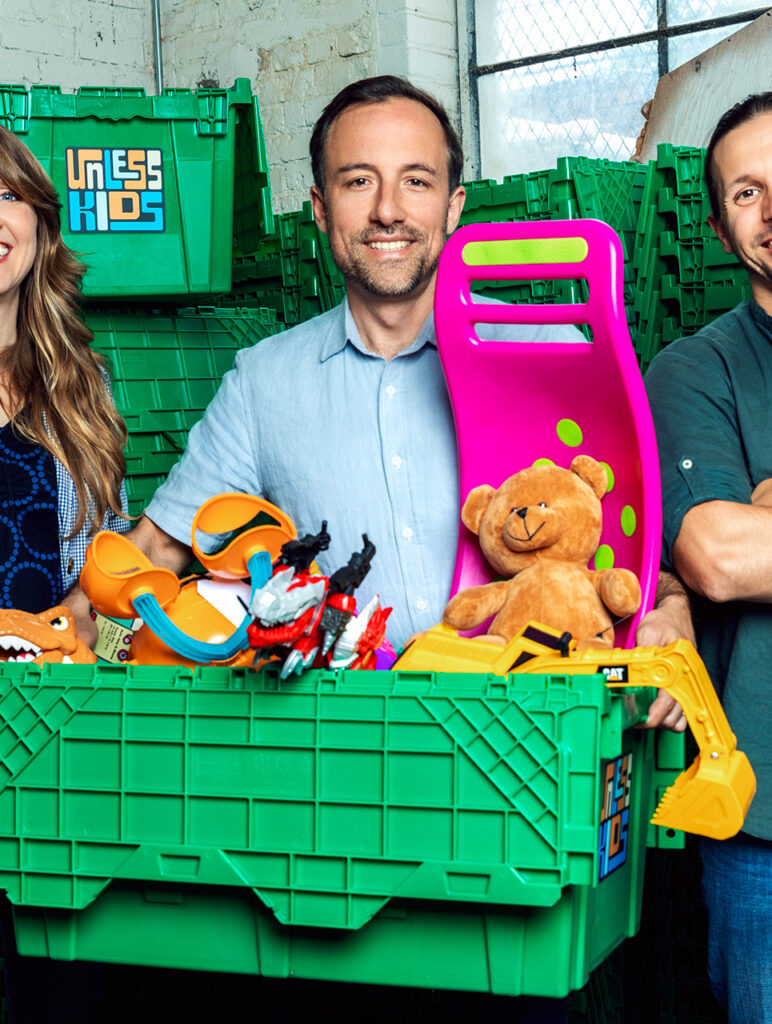This story was originally published in Hidden City Philadelphia.
Last fall, after Philadelphia announced the release of a request for proposal to develop one of the most notoriously blighted areas of the city, the Logan Triangle, a bevy of reporters called up Charlene Samuels, chairperson for the Logan Civic Association, to get community perspective.
With more than a hint of exasperation in her voice, she told them all a version of the same thing: “Just sit and wait and see.”
And also: “Hope and pray.”
That’s what it’s come down to in Logan, where the wrongs of a century past and decades of unkept promises have left residents skeptical anything good will come of the 40ish-acre eyesore, which drags down the name of a neighborhood many are otherwise proud to live in.
The story of the Logan Triangle has been told many times. In the early 20th century, a stretch of the Wingohocking Creek in the Logan section of North Philadelphia was covered up and converted to a sewer. Developers then filled the valley with up to 40 feet of coal ash and cinder in order to grade the site and build dense housing. The charade lasted less than 50 years, when gas lines started to explode and homes began sinking into the earth. The issue also came to a head just after the neighborhood’s demographics shifted heavily toward Black families, who now comprise 84% of Logan’s population.
In the end, more than $30 million of taxpayer money was spent to buy out and raze nearly 1,000 homes. The land has since been left cracked open like a wound, festering with dumped garbage, weeds and crumbling concrete.
The psychic wound remains just as gaping.
This is environmental racism. If we were a different complexion of people, would this be happening?”
— Charlene Samuels, Logan Civic Association
“This is environmental racism,” Samuels says. “If we were a different complexion of people, would this be happening? I just don’t understand it. Why would anyone allow this to be happening?”
The land is currently owned by the Philadelphia Redevelopment Authority (PRA). In November 2023, the agency released an RFP that, in a perfect world, could deliver a solution. The City has asked prospective developers to submit proposals for what they’d do with the land, with no tax abatements or other financial costs borne by the City, and following community-oriented guidelines developed over the past decade. The City’s submissions deadline was January 11, 2024, and officials planned to announce a selection by the end of February.
But few — if any — think development is likely to happen under the current circumstances. Mohamed Rushdy, a local real estate developer, freely offers disbelief that any developer is going to put forth a working proposal for Logan Triangle without any economic incentives.
“I looked at the RFP and thought, ‘Well, okay, I am not sure there is going to be a humongous response, if any,’” Rushdy said. “Just because of how large it is, and what’s needed to make it pencil out, especially in a tight credit environment … It needs money to be developed.”
For those who’ve spent a lot of time working on the issue, it’s hard to even summon the energy to read the details of the RFP. Just eight years ago, the City performed a similar RFP and selected a developer in The Goldenberg Group, which in 2023 walked away without breaking ground on redevelopment. Samuels says that leaves recent developments feeling like déjà vu and neighbors disengaged.
Scott Quitel, a professor of social entrepreneurship at Drexel University who has spent considerable time in the neighborhood engaging with community members about a potential future of the site, is of a similar mindset.
“This is one of the biggest sins of the City,” Quitel says. “There’s so much hopelessness.”
And yet he can’t help but wonder if there’s at least a sliver of potential that the future could hold better things for the site, if only everyone involved can bring themselves to suspend disbelief and hit reset. He’s still actively speaking to those in his network to see what potential positive outcomes could be achieved.
“I know [residents] are exasperated from all these promises that weren’t kept over the years,” Quitel said. “But what if we could make believe none of that ever happened, and say, ‘Here we are in the year 2024. What’s the site telling us, what are the possibilities?’ And give the neighborhood, as close to 100% as possible, an understanding about the site and what the possibilities are.”

A buried past
The development of what is now the Logan section of the city stretches back more than three centuries, when James Logan, Pennsylvania’s colonial secretary and mentor to Benjamin Franklin, assembled about 500 acres of land in the area to establish a plantation positioned between Philadelphia and Germantown called Stenton.
The estate then passed down through six generations of the Logan family until the City took ownership of the mansion in 1909. But by then, records show the Logan family had already divested much of the estate’s acreage, with large tracts of the land owned by other well-to-do Philadelphians, such as Joanna Wharton Lippincott and Harriet de Benneville Keim. Running through the lands from west to east was the Wingohocking Creek, a major tributary of the Frankford Creek that stretches from present day Mount Airy to Juniata.
Further transformation would arrive in the decades that followed. By 1910, an updated atlas shows, the Wingohocking had disappeared from the maps, as it had been encapsulated and turned into a sewer. The lands had also changed hands: much of the modern-day Logan Triangle was now in possession of the “Realty Development Company.” These developments set the table for the original sin of Logan Triangle.
At that time, there was a company known as Wolf Brothers & Co., whose membership included brothers Benjamin, Louis, Albert, Edwin and senior member Clarence, who, according to an 1899 Philadelphia Times article, was “widely known in financial circles.”
The Realty Development Company, historical records show, was owned by one or more brothers of the Wolf family. An April 1912 Philadelphia Inquirer article names Edwin as president of the company. Additional coverage from around that time shows the company was purchasing large tracts of land from the Wharton Lippincott and de Benneville estates.
According to a chapter from “Utility Cars of Philadelphia,” a 1971 book by author Harold Cox shared with Philadelphia Water Department historian Adam Levine, by that time the Wolf brothers had bought up at least 80 acres of land along the new Torresdale (now Roosevelt) Boulevard in the vicinity of Logan. With the creek’s encapsulation came a new opportunity to fill, grade and further develop the area.
“It was estimated that it would take about 500,000 cubic yards of material to fill the depression at a cost of about $425,000,” Cox writes. “The new owner, Clarence Wolf, however, had other ideas.”
According to Cox, Clarence had a wide range of political and business connections. He served as financial advisor to then-Philadelphia mayor John Reyburn. He leveraged this connection to become a board member of the Philadelphia Rapid Transit Company (PRT), which, according to the Pennsylvania Historical Society, was the predecessor to SEPTA. He also was a major stockholder of the PRT, Cox wrote.
Even more, William Benson, chief of the Bureau of Highways and Street Cleaning for the City and George Stearns, director of Public Works, had previously worked for Clarence Wolf, Cox found. These bureaucrats initiated a sequence of events in which contracts were issued to PRT to haul waste ash via streetcars from the city’s core to a “dump” in what is now Logan.
“Curiously enough, the dump used by PRT was the Wolf lands on the Boulevard,” Cox wrote. “The Philadelphia Record also found it curious that the dump caught fire at frequent intervals and the City fire department was called out to douse the blaze and, incidentally, to help compact the fill. It also thought that the decision of the City to open 9th Street through the middle of the lands in question was one coincidence too many.”
A doomed neighborhood
The scheme complete, homes would now be built atop these shaky grounds. Records from the time suggest it was done piecemeal. An October 1913 Inquirer article reported that a Charles A. Mahon had purchased a plot of land making up a small portion of the modern-day triangle from the Realty Development Company and planned to build twenty homes on it. Later articles suggested a builder named Daniel Crawford Jr. made a significant development play in the area.
It’s unclear how much these builders knew about the fill used to grade the area. But within a generation, problems emerged.
On Halloween Eve 1959, the PhillyHistory Blog writes, citing contemporaneous newspaper articles, a series of three explosions rocked homes on West Roosevelt Boulevard within the modern-day triangle.
“Six-and-a-half feet under the east side of 9th Street, a 30-inch gas main developed a crack,” the blog retells. “Gas seeped into underground pockets and went undetected until five homes about 25 feet away … were racked by three explosions that shook the neighborhood and set fire to the houses.”
Although no one was killed, at least one resident was hospitalized and several others were knocked to the floor or violently driven from their homes by fire and smoke.
But the incident was buried, until a more infamous set of explosions shook the neighborhood once again in 1986. At that point, problems had proliferated to the point that neighbors of Logan approached Mayor Wilson Goode and demanded that the City “solve this problem,” the blog records.
Records show the City responded by hiring an engineer that determined the extent of the problem. It then formed a nonprofit organization and spent more than $30 million purchasing and demolishing the homes and relocating residents.
Lost trust
Inseparable from current discussions about the land are additional historical developments.
For many current residents of the predominantly-Black Logan neighborhood, racial considerations are inescapable. An infamous 1934 map of the city by J.M. Brewer shows Black neighborhoods of the city literally in red lines, while Jewish neighborhoods received blue and Italian neighborhoods green. The map coded much of the current-day Logan Triangle as blue for its Jewish population, whose historical presence in the neighborhood was retold by writer Rosanne Skirble for Tablet magazine.
“Records from Beth Sholom, Logan’s first synagogue, refer to the neighborhood as the ‘suburbs,’” Skirble writes. “It starts to fill up with Jewish families and remains predominantly Jewish from the 1920s through the 1950s.”
Skirble describes the Logan of that era alive with a rich tapestry of Jewish life. But she quotes Michael Schatz, a Jewish educator and historian of Jewish Philadelphia, as stating that many families still “had an eye on a little piece of land or a newer, bigger house in the suburbs,” and most had moved out by the time of Logan’s reckoning in the ’80s.
Replaced by mostly Black residents, as well as a sizable Latino community, newer residents like Samuels can’t help but wonder what was known at the time homes began to be sold in large numbers to Black families.
“I believe — I could be wrong — but my perception is that they knew those houses were sinking then,” Samuels says. “But they allowed Black people to move into those houses. And even then, when they did report that they felt their houses were sinking, they were not listened to.”
After the explosions precipitated the buyout program, former residents say additional injustices followed. Samuels says she believes homeowners weren’t adequately compensated, while others have written that the City forced some residents from their homes with legal threats.

What’s next for Logan Triangle?
In 2013, the now-defunct Logan CDC received a neighborhood planning grant from the Wells Fargo Regional Foundation. Three years later, in conjunction with the PRA, a resulting 154-page report was issued, providing a comprehensive plan for the entire neighborhood, including a significant reimagining of the Logan Triangle.
According to the report and its review of available engineering assessments, the grounds of the 35-acre Logan Triangle are most unstable in the center of its sprawl, where dumped ash runs 40 feet deep or more. But the edges of the triangle are significantly shallower and more stable. As such, a trio of plans were developed to promote mixed use development along the triangle’s edges and allowing varying scales of open space in its core.
By the time the report was released, the City had already selected The Goldenberg Group to redevelop the land, according to a September 2015 PlanPhilly story.
“First of all, I want to say I know the City has been absent for too long,” Brian Abernathy, then- executive director of the PRA, said at the time. “I know we haven’t served your community well over the last 30 years, and I apologize for that.”
But the promises to Logan once again dissipated. In 2023, news broke that The Goldenberg Group was walking away from development plans, which included a basketball recreation center and library. That sent the City back to square one to seek another developer.
Exactly what will come next is anyone’s guess. Miguel Pando, a professor of geotechnical engineering at Drexel University, said that in a vacuum, anything could be built on the site. Engineering techniques such as driving foundation piles down to bedrock to support slab construction could theoretically support even heavy development on currently unstable portions.
“Engineering-wise, we can do anything,” Pando says. “We have a tunnel connecting England to France.”
But of course, Pando says, engineering solutions cost money, and the costs rise higher the deeper you have to dig.
Rushdy says he’s heard whispers about calculations that show adding deep piles to support development could add $20,000 to $30,000 in extra costs per unit. If 900 homes were built to roughly replace the housing stock there previously, that adds up to $27 million of extra costs.
For these reasons, Rushdy thinks the City or State will have to generate some kind of substantial economic incentive to make a deal work. Given his profession as a real estate developer, Rushdy thinks mixed-use residential could work for the site, particularly if the land was subdivided to entice smaller outfits, instead of trying to find one single investment whale with enough capacity to take on the entire project. But, he says the community should ultimately be consulted on what comes next.
Quitel, the Drexel social entrepreneurship professor, agrees. But with a background in ecological restoration, Quitel promotes a more passive use, where much of the land of the Logan Triangle would be devoted to well-lit and carefully designed open space and given time to heal.
“The site is telling you what it wants to be,” Quitel says, adding that sinkholes are still actively developing.
Asked what she’d like to see, Samuels becomes blasé. Sure, a new state-of-the-art school to help with current overcrowding would be nice, or maybe affordable housing for the city’s seniors and economically disadvantaged residents.
But it’s hard for her to believe anything is going to come to pass, given the full history of the Logan Triangle. Like Rushdy, she too thinks nothing will get done without significant public investment and wonders why the City hasn’t been putting any money away over the past three decades to help right a major wrong it was complicit in a century ago.
“When will the Logan community be made whole? And that’s whole with a ‘W,’” Samuels says. “It’s just not right.”










That is 43 acres of lead ash. The fact that developers are even planning anything on that site is more than just environmental racism it’s absolutely insane. Those same home on homeowners can’t get insurance for their roof or basements because 10 to 20 blocks around that triangle is unstable.
The best thing for the city to do is to allow the EPA and NRCS to come in and cap that site like they did the former Greensgrow site.
And would really makes me angry is that the city knows this and they keep screwing with the neighborhood and those residents feelings because they’re not being honest or truthful about that site. Because of the city screw up the only people that should be remediating that piece of land are federal agencies with an EPA and NRCS, not developers.